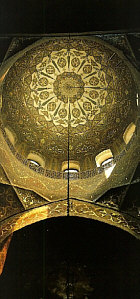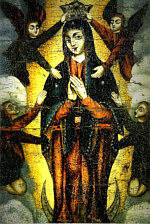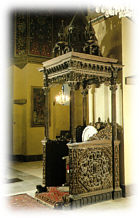The
two paintings flanking the main doors are
of Ss. Poghos (1) and Petros (2), and the two
grave stones underneath are inscribed in Grapar: (left of door)
"1163 - 9th month… in 1405 Ter Aghexander Katoghikos laid in the mausoleum
November", and (right of door) "Son of Christ the only son Ztraghksand'r
Riiznadtsi - November 10".
Legend and Movses Khorenatsi’s 5th century History of Armenia say that the first cathedral at Echmiadzin was erected by King T'rdat III and Grigor Lousavoritch in two years, between 301-303 AD. According to these accounts, the exact location and design for the cathedral appeared to Gregory in a vision, where Christ descended to the Ararat Valley with a golden hammer in his right hand and struck the locations where four churches were to be built: three Martyria (two of which were to be dedicated to the martyrs Hripsimeh and Guyaneh), and the future cathedral at Vagharshapat.
The "Ijman Seghan" or Altar of Descent at the center of the Cathedral is the location of Christ's appearance in the vision. Hence the name Echmiadzin (which means ‘the descent of the Only Begotten’).
The vision described the church composition while interpreting its elements. The main site was marked with a circular base of gold on which rested a column of fire with a capital of cloud, surmounted by a cross of light.The sites for the martyr’s chapels were marked with red bases, columns of clouds, capitals of fire, and crosses of light; these columns were lower than the central column. The whole construction was surmounted by a canopied construction of cloud in the form of a dome.
[Figure 1] As you enter the church, look at the floor plan. The original cathedral was intended as a physical duplication of Grigor's vision, and is believed to have had a quadruple apse (cruciform) hall and four corner chapels. Close off the corners of the present church, imagine the entire structure as a square with very thick walls and no windows, and you have the original design.
[Figure 2] When the church was transformed in 484-486 into a central plan with corner niches, the four semi-circular apses were rebuilt to protrude out from the ends of the cross, and two chapels were added on the North and South sides, flanking the main altar. That is essentially the church as it exists now, except it had a smaller wooden dome which was replaced by the current one in 618 AD.
[Figure 3] Now add the Western bell tower, the church museum behind the main altar, and the results of the 1955-57 renovation, when the structure and foundation were reinforced, the floor was marbled, and the murals were restored.
The overall decoration of the Echmiadzin Cathedral is tied to the Hovnatanian family of painters. The first of these is the painter Naghash Hovnatan (1661-1722), who was also a poet and scribe of Shorot as well as a bard. The painted dome is a portion of his work. Another is the Madonna painted on the marble frontal (33) of the high altar.
The entire composition was later completed by his descendants, including the Twelve Apostles by his sons Hakop (ca. 1757) and Harutiun (mid 18th century). During the reign of Katoghikos Ghukas, Naghash's grandson Hovnatan Hovnatanian (1730?-1801) continued decorating the Cathedral, adding most of the paintings. Assisting in his work were unknown Armenian apprentices. Paintings were also created for the cathedral by Hovnatan' son Mkrtum (1779-1846).
As you enter, you will see a repeated pattern of cherubs with six wings. Gold leaf sets off the each face against a deep color tone. The number 12 is repeated throughout the dome: twelve windows in the supporting drum, twelve winged angels above each window, twelve ‘trees of life’ pointing to the inner circle of the dome. The color scheme moves from more earthly tones at the lower edge to blue and gold and green as the design reaches the upper dome, with red and gold delineating the inner design. Unfortunately years of candle and incense smoke hides much of the detail, and the interior is poorly lit.
Like the frescos and marble paintings, canvas paintings are almost exclusively by the Hovnatanian family and school, except for the Avetun diptych facing the entrance: Archangel Gabriel (14) and The Annunciation (9), which were painted by Stepanos Lehatsi (?-1689), and Stepanos Nersissian's (1815-1884) portraits of Mesrop Mashtots (13) and Sahak Parthev (10).
Interspersed with traditional themes like Hovnatan Hovnatanian's Madonna and Child (17), Baptism (15), Christ Washing the Apostles' Feet (29), The last Supper (37) and Coronation of the Virgin (46) are purely Armenian subjects such as the anonymous The Madonna with John the Baptist and Gregory the Illuminator, and Hovnatanian's Gregory the Illuminator (47), St. Thaddeus the Apostle (30), St. Bartholomew the Apostle (36), St. Nerses Schnorhali (16), Naghash Hovnatanian's Hovhan Hovnetsi (7), and the anonymous The Founding of Echmiadzin (27).
Included in The Founding of Echmiadzin are pictures of Armenian kings, from the first king Haik to a contemporary of Christ named Apkar, to the figures between T'rdat the Great and Khosrov.
Ijman Seghan (11) Two altars face the main entrance to the church. The one in front is the Ijman Seghan, or Altar of Descent, where Christ is believed to have struck the earth with his golden hammer in S. Gregory's vision. The lower edge of the marble platform is painted with tongues of fire. Originally the altar had a marble canopy set on pillars, which was moved to the high altar at Guyaneh Vank.
To the left of the Ijman Seghan is an elaborately carved 17th century throne (12), with a model of the cathedral on the canopy. It was a gift from the Roman pope to the Catolicos Yeghiazar.
High Altar (34) The high altar in front of the Ijman Seghan is called the Cushion for the Holy Cross. A relic of the true cross is believed to be within the reliquary just below the painting of the Virgin Mary and the Christ Child (35). Note that the crosses on the columns on either side of the altar emphasize the number 3, and that each end of the cross incorporates 3 design points (for the three natures of God).
The frontal decoration (33) were painted with gold leaf detail and feature the 12 apostles, the Virgin and Child, S. Stepanos on the left, and S. Pilipos on the right. Repeated use of cypress-like trees reinforces the tree of life effect in the dome.
The second throne (31) is to the left of the high altar, and was probably made in the city of Ak'n, donated to Echmiadzin in 1712. It is heavily gilt with gold leaf, the columns and side panels covered with mother of pearl. Both thrones are used by the Catolicos when he attends service.
North and South Chapels Paintings of the apostles include those of Ss. Thaddeus (39), Paul (20), and Bartholomew (21), who are believed to have preached in the provinces of Siunik and Goghtan (present day Nakhichevan) ca. 100 AD. They are also believed to have been killed by King Sanatruk Arshakuni who considered the conversions a danger to his power: among those who converted were members of the court and his sister, killed with other early converts. The Armenian church is an Apostolic Church, tracing its roots to these Saints.
Cathedral Interior
NOTE: See ECHMIADZIN CATHEDRAL. Numbers correspond to "(X)" on this plan.



Interior Frescos

Paintings

Ijman Seghan (11)
